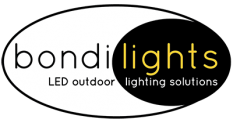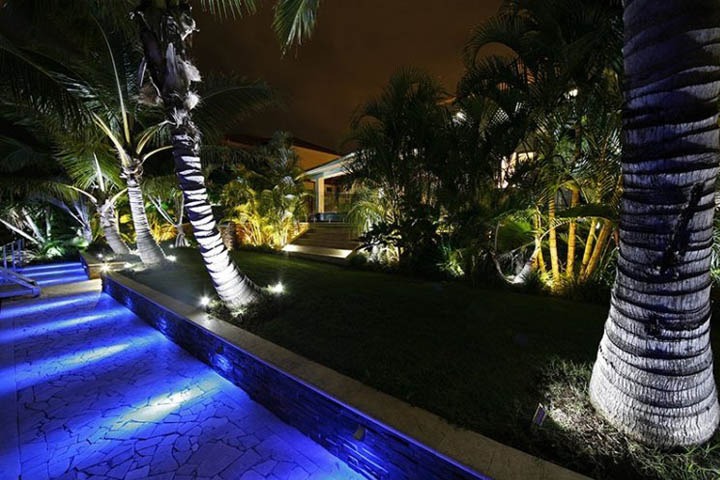Tree lighting is most certainly a bit of a project, but the results are well worth it. The trick is knowing how to choose the right kind of lighting and placement—whether it’s spotlighting for that dramatic effect, floodlighting for a broad wash of light, or accent lighting to bring out delicate details. With a bit of know-how from the garden lighting specialist in Sydney, Bondilights, your backyard can go from ordinary to extraordinary with just a few strategically placed lights.
Tree lighting’s tried-and-true techniques
The popular tree lighting methods are popular for a reason. You just need to decide which best suits your trees and the vibe you want to create:
Uplighting
Uplighting is one of the most popular methods, and for good reason—it’s simple, impactful, and adds a magical quality to any tree. This technique requires you to place the light source at the tree’s base and point it upwards to highlight the trunk, branches, and foliage. Uplighting creates a striking effect that’s great for making your trees stand out as focal points in your garden.
To get the most out of uplighting, consider the shape and size of your tree. For taller trees or those with narrow canopies (like palms), narrow spotlights can create a dramatic vertical effect. Meanwhile, wide-beam uplights work well for trees with broad canopies, illuminating the entire crown even from a close distance.
Downlighting
Downlighting flips the script—lights are mounted higher up in the tree, shining downward to create a soft, natural glow on the branches and surrounding ground. This technique is ideal for areas where you want to create an inviting ambience without casting sharp shadows. Downlighting mimics the effect of moonlight, which is why it’s sometimes called “moonlighting.” This method can add depth and dimension, making it perfect for smaller accent trees and larger garden areas.
For downlighting, wider beam angles (like flood or wide flood) are typically preferred to spread light over a larger area. This approach can also improve visibility and safety in your yard, lighting up walkways or seating areas without overwhelming the space.
Accent Lighting
Accent lighting is your best friend if you want to bring out specific details of your trees. This technique uses focused beams to highlight elements like a branch, unique bark texture, or a flowering canopy. Accent lighting is great for drawing the eye to special features, creating a layered lighting effect that adds depth to your landscape design.
Choosing the right beam width is key here. Narrow spotlights are ideal for smaller, detailed features, while wide-angle beams work better for larger sections. You can even play with coloured lights if you want a more artistic, whimsical effect.
Choosing the light distribution
The shape of your tree should guide your choice of light distribution. For example, trees with tall, narrow trunks and small canopies benefit from narrow spotlights, while wide, expansive trees look best with wider beam angles like a wide flood or extra-wide flood. For slender but tall trees, an oval beam angle can cover the height while keeping the light concentrated in a narrower band.
Positioning your tree lights for a balanced, all-encompassing glow
Your tree should be an eye-catching feature, even from afar. Where you place each light can make all the difference, especially when working with large, sprawling trees or smaller ornamental ones. Here’s how to approach it:
Illuminating large trees
Achieving a uniform, balanced glow usually means using multiple light sources for a larger tree with a broad canopy. Placing three luminaires at 120-degree intervals around the tree is a reliable method for even coverage. This arrangement ensures that the entire crown is illuminated from multiple angles, giving the tree a more three-dimensional effect visible from all sides. Positioning each light farther from the trunk prevents hotspots and creates a softer, more natural glow.
Highlighting the trunk and lower canopy
If the goal is to draw attention to the tree’s trunk or lower branches, positioning a luminaire close to the base works best. This approach is ideal for accentuating texture, such as interesting bark patterns, or emphasising the form of the trunk itself. Lights placed closer to the trunk create a more focused, intimate effect, which can be especially effective for showcasing smaller trees or adding dimension to a broader landscape design.
Mounting accessories for versatility
When positioning your luminaires, it’s worth investing in mounting accessories like ground stakes, cross-arms, or adjustable extensions to keep your setup flexible. Ground stakes are particularly popular for tree lighting, as they allow easy adjustments and secure anchoring, even in coastal or rugged settings. Spike lights, often made from materials like marine-grade steel, are excellent for enduring outdoor conditions and are easy to move as trees grow or your landscape changes.
Designing your look with a garden lighting specialist in Sydney
Bondilights experience in outdoor lighting design is available to help you create captivating, energy-efficient lighting setups that enhance the beauty of your garden. Our goal is to make sure your outdoor space is just as inviting and magical at night as it is during the day with lighting to suit your trees’ natural charm.
At Bondilights, we use energy-efficient LED technology purposefully designed to withstand the unique challenges of the Australian climate. Our lighting fixtures are built with style and durability in mind. Because no two gardens are the same, we tailor each lighting solution to perfectly suit your specific trees, plants, and layout, allowing your space to become the enchanting nighttime retreat you’ve envisioned.
Our dedicated lighting specialists handle planning, product selection, installation and ongoing support. We’re passionate about extending your enjoyment of the outdoors with designs that transform your garden, so let’s discuss your lighting setup today.

